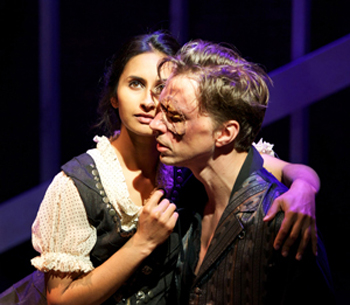
The rules of stage decorum require heroes to wear their injuries with grace, leading most productions to merely suggest Rochester's disabilities by means of an empty sleeve-cuff and a pirate-style eye patch. In Christina Calvit's steampunk-tinged adaptation for Lifeline Theatre, though, actor John Henry Roberts displays his persona's mutilated visage in full view of the audience.
The proliferation of war veterans in our society today has accustomed citizens to the sight of surgically-repaired wounds, but prosthetic designer Aly Amidei's admits to looking at "a lot of gruesome photographs" in the course of her research, "I wanted to see the remnants of empty orbital sockets, so I could impose on them the contusions and burn marks from the falling beam—but also to suggest some signs of healing."
Solid cosmetic pieces are not one-size-fits-all, however. After making a life-mask of Roberts' face, first in alginate and then in plaster, Amidei sculpted the shape of the mangled flesh out of clay to create a mold into which she poured liquid latex. Once dry, this was removed and colored to match Rochester's makeup. Since most theatrical adhesives cannot be used near actors' eyes, the artificial scar is attached with more latex. "I offered to cut him a peephole covered with scrim, so he could see through it, but [Roberts] assured me that he didn't need it."
"The hardest part of working with only one actual seeing eye," reports Roberts, "is playing Rochester's total blindness—for example, when I hear Jane's voice, I turn toward the sound, but I can't look directly at her. I also have to leave [the prosthetic] on for curtain call—there isn't time for me to take it off—and since I can't see Anu [Bhatt, who plays Jane] just to my left, the cast has to bow on my cue."
Both actor and technician agree that the visibility of Rochester's damaged body enhances the story's dramatic intensity. "Christina's adaptation clearly indicates that it's not Rochester's looks that draw Jane to him," asserts Roberts, "Early in the play, when he asks if she thinks him 'handsome,' she says no—and when she encounters him after the fire, he has not been living well. Nothing is easy for these two."
Amidei concurs, "Jane's love for Rochester remains unswayed by his physical injuries—and perhaps his suffering has rendered him more deserving of that love. The choice to show his scarred face ultimately makes a really strong statement about the journey of these lovers who must overcome so much before finally finding happiness together."
Jane Eyre runs at Lifeline Theatre through November 16.
Mary Shen Barnidge
Contributing Writer
